The wheels that make your luggage easier to move require more consideration than just deciding between in-line or spinner types. When you’re relying on something that’s supposed to get your heavy suitcase across the airport, if the wheels don’t perform you have to look into everything that could come up as a problem. If you travel for business, your turn-around time can be minimal, and you don’t need wheels that fail part way through the trip.
Wheel Options
We’ve already discussed the two kinds of wheels that you can get on luggage. They come in configurations of two wheels that only go backward or forward and are made out of in-line skate type wheels. There are also four and eight wheel configurations that spin in all directions, and allow the case to stay upright rather than tipping forward when it’s moved.
Considerations
The type of wheels you go for when deciding which bag is right for you is important. You need to look into the quality and make sure that, even though the bag is sturdy and able to stand up to a beating, the wheels are too.
 For instance, in-line skate wheels tend to be made out of rubber that, if it’s not high quality, scratches easily and becomes uneven. These wheels can become punctured and snag on things, and they can fall off. While you don’t have to worry about them losing air pressure like the wheels vehicles rely on, they do lose their shape and become unreliable if they’re too beat up.
For instance, in-line skate wheels tend to be made out of rubber that, if it’s not high quality, scratches easily and becomes uneven. These wheels can become punctured and snag on things, and they can fall off. While you don’t have to worry about them losing air pressure like the wheels vehicles rely on, they do lose their shape and become unreliable if they’re too beat up.
Some spinner wheels are more like wheels on a bike or car compared to in-line skate wheels. They have a rubber tread that’s stretched over the actual wheel, and the treads can come off if they’re poorly constructed. The bag then comes uneven or the wheel stops spinning all together (not the best thing to happen when you’re late for a plane)!
Wheel Confusion
Unfortunately, there is not a clear winner between the in-line or spinner option. You’ll have to read thoroughly to make sure you’re getting what you need out of the bag AND the wheels. They act independently, so a good bag can be made unusable by crummy wheels.
You also want to make sure the wheels on the bag are large enough and spread far enough apart. As bags get larger, the wheels should too.
Additionally, spinner wheels can come in two configurations: four wheels and eight wheels. Eight wheel sets add stability to the movement, and that’s vital for larger bags. Four wheel spinners of the appropriate size should be more than substantial enough to support the weight of a carry on sized rolling bag. That being said, many of them still include the 8-wheel sets for added stability.
Wheel Size
Cases that have eight wheels tend to be more expensive, but they also provide an added level of stability that allows you to keep the bag upright without a lot of support from you. The larger the bag, the more likely it is to be carrying heavy items, so you want to be sure the wheels at the base are large and strong enough to support the weight of what is in your potentially checked baggage.
You could have 32 wheels that are too small to hold the case, and it would probably still fall over. The number of wheels adds extra stability, but you have to work with the correctly sized wheels first. On the other hand, wheels that are too large can be bulky and cumbersome. Sometimes, they don’t turn appropriately because the weight on them is not sufficient.
Check For Quality First. Style Second
Make sure the wheels on the case you choose are of a quality that suits the bag. Duffel bags with wheels that are used for short trips may not need the highest quality wheels on the planet, but a bag for business travel should definitely have wheels that are tightly connected without any wobble when they roll. Check the attachments and make sure there are not any screws that need tightening. If that continues happening, the wheels may not be reliable.
